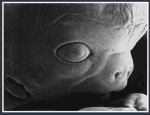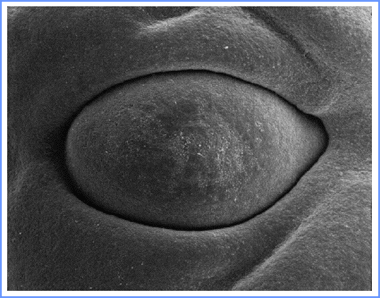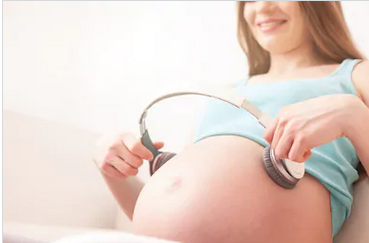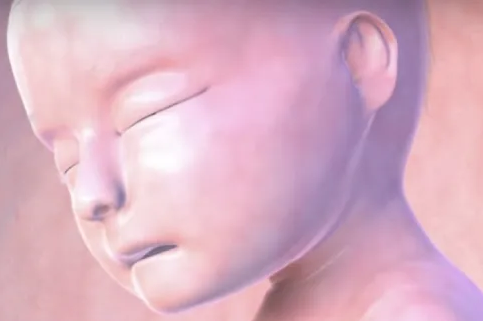Right after the delivery we take our babies and pack them into a cloth that holds their hands and legs close to their bodies, to let them feel hugged and safe. And so we tend to forget that they can already move, that back there in the womb, they were moving, touching, listening, observing. We greet every move of their hands and legs with huge applause. We observe how they start pseudorandomly move their hands around, kicking legs when they want to reach a toy as they are exploring options of their bodies. Like every mum, also I can spend many hours just watching how is the little baby exploring the world around. Slowly, as they touch by their hands and legs surrounding objects or themselves, they start to move more and more intentionally, and we focus on every step of their development with incredible attention. All this seems to be a continuous development with the starting point at delivery. We tend to forget about their first kicks in our belly, by which they were letting us know that they are already there, about those long nine months which they spent exploring the womb. How it was in there? How often they move, how important is their motor development inside the belly for their future motoric development at all?
Compared to other infrahuman primates (this means chimpanzees, apes, and others) human babies have delayed development [1, 2]. This means that for many weeks after the birth, the baby actually does not change much its behavior compared to what it was doing inside the womb. It is still not able to care for itself and needs long term support from the mother. It seems that there is a central movement pattern generator [2] in the brain, which creates various movements (either general movements of the whole body or isolated movements of the individual limbs) and this same pattern generator is serving the body both before and after birth [3]. This gives us an amazing option to see, how was our precious bundle behaving inside our belly – which movements it used to do, how it sometimes accidentally touched its head by its hand, how it was sucking the amniotic water, how it was breathing, yawning, swallowing, kicking,… It takes up to 3 months after birth when these mainly random predefined motor patterns change to more intentional goal-directed movements, that are guided by the sensory system (which was also not fully developed in the first weeks after the delivery so the baby had to wait a bit longer to be able to make use of it) – and the baby can finally reach for a toy by hand or rotate in its direction…
Development of the motoric system
The motoric system is one of the first systems in the fetus’s body which starts to develop. It was shown that it is crucial for brain development that the motoric action provides an appropriate change in the sensorial world (e.g. we can feel that we touched something or we can see that something moved, etc.) (see e.g. Held and Hein [4] who performed a classic experiment with kittens). Thanks to modern ultrasound devices we can observe gradual changes in human fetus development in detail. First longitudinal studies were performed in the 1980s by Prechtl [5] and uncovered till that point many unknown phenomena about that secret world “inside”. From the studies of the motor patterns, we can nowadays observe also the brain connectivity of the fetus and see for example that good connectivity of some regions (prefrontal cortex, motoric network, supply motor regions, and temporal lobes) in the fetus brain is very important for later post-term motor development of the kids (Thomason, 2018). In this study, they found out that the connectivity also differs between female and male fetuses and discusses that this might be related to the later sex differences between infants. There are studies that show that female infants are better in fine motor skill development, while males in gross motor [6] or those female infants show more coordinated arm movements [7].
When do individual movements start?
As soon as in 8 weeks of pregnancy the fetus starts to move sideward its head [8]. These first body movements are followed by generalized movements of the whole body in 9-10 weeks – the whole body is either moving slowly in a sequence (general movements) or all limbs, trunk, and neck are moved by quick phasic movements (startles) [9]. It takes another week or two when we can (between 10-11 weeks) observe isolated local movements of one arm or leg. Isolated movements of some parts of the body are way more difficult to produce than whole-body movements both for the fetus as for the newborn. Teaching individual brain regions of the motor cortex to specialize for moving individual body parts will be under development for many years so it is no wonder that it is easier to generate in the fetus brain activity responsible for the whole-body movement. Just imagine when someone asks you to move one of your toes on your feet. Can you manage?

(Image: © Stefaan W. Verbruggen, et al./Journal of the Royal Society)
In the 10 weeks of pregnancy come hiccups. These movements are caused by repetitive short contractions of the diaphragm, which might last for several minutes and as you well know, they can be pretty annoying. Sometimes they might be so strong that they move the whole fetus in the womb.
If you wonder when the baby can already move its head to sign “no” or “yes” to your question by moving head back and forth or rotating it from side to side, it is actually as soon as in 11 weeks of pregnancy. At that time, the head becomes mobile and can move forward, backward, and rotate. It means that now we have to just find the way how to let the baby know that it can use it for communication with us and by observing the womb via ultrasonic devices, we can see if it likes or dislikes what we do 😊. What is great is, that this general pattern generator for limbs and head movements might create at this point accidental hand-eye contacts. These are totally not intentional, but still, provide important information for the fetus. These are the first self-contacts that enable later self-awareness of the baby and a better understanding of its own body. Same as we tried in our research where the robot was trying to touch itself to find out the length of its arms and torso as well as the position of its eyes (cameras) (Stepanova et al. [10], https://www.youtube.com/watch?v=zP3c7Eq8yVk&feature=emb_logo ).
In 11-12 weeks we can observe periodical breathing of the fetus and in 12 weeks we see stretches and yawns. It might impress you to observe your newborn yawning as it seems so mature. The fact is, that these movements which appear as soon as in 12 weeks of pregnancy will keep the same form and pattern for the whole life. Cool, right?
Sucking. You might be impressed by the newborn sucking reflex and then the strength of the sucking itself (at least some of the kids, some others need a lot of stimulation and their sucking is very weak). How quickly it finds the place to suck and how much it hurts when the baby actually sucks accidentally in the wrong place. No wonder, it has good training also for a few months before it comes to the world. After 12 weeks of pregnancy, the baby starts to drink the amniotic fluid, that is connected to first sucking and swallowing movements. As the sucking might happen in the womb all the time, after delivery, the baby will have to learn to connect this sucking behavior to feeding occasion – yet some of the kids would love to continue in the “sucking all the time” behavior 😊. Sucking reflex itself (meaning that the baby starts sucking as it gets nipple or something else to the mouth) develops around 32 weeks of pregnancy. (https://www.healthline.com/health/parenting/sucking-reflex#test).
At around 20 weeks, the baby starts to prepare for the outside world and first slow eye movements (20 weeks) followed by rapid eye movements (22 weeks) develop. [11]
As the fetus is growing and space is getting restricted, most arm movements end up not far from the face, and the amount of hand-face contact increases [12]. The first movements are mainly unintentional, later there are also more and more non-reflexive responses to sensorial inputs – like to sounds, light (response to disturbances [13] or movements towards the source [14] (see also my earlier blog post about the language development), response to the maternal touch of the abdomen by an increase of arm, head and mouth movements [15] as well as changes in fetal heart rate. But still, most of the movements are only ‘‘motor babbling’’ – the spontaneous activity of the fetus.
By about week 21, the fetus begins to develop a regular schedule of movement [16] The startle reflex is present in half of all fetuses by week 24 and in all fetuses by week 28.
After the birth comes with sensory inputs also new options and new movements. The baby must deal with the gravity, it has to learn how to deal with the lung ventilation and so we can observe sneezing and coughing and so on.
The motor cortex of the fetus
It is believed [12] that the fetus is creating connections between motoneurons and muscles via these spontaneous movements when via general and isolated movements it receives various types of stimulations. In this way, specialized areas in the brain that are created to operate given body parts might be created. When individual body parts touches another body part or the outside world as well as when an outside stimulus triggers some sensation, all of these contributes in the creation of new neural connections and enable the fetus later to repeat any movement. You can see research about creating these somatosensorial maps in the brain of the humanoid robot (https://www.youtube.com/watch?v=ONiKEtIJc3Q&feature=emb_logo , Hoffmann [17]).
How often do babies change their position in the womb? And should you be worried if they do not kick enough?
I guess that every mother goes at some point through that scary moment. Sitting on the sofa and thinking that the baby did not move for too long. Starting to worry, counting seconds, getting scared if everything is ok with the baby. Should I call a doctor? Should I worry? What is wrong with this baby? Or when you come to the monitor before delivery and you everybody around gets “a nice” monitor immediately, only you are the one staying there longer, breathing deeply, sisters changing your position that the baby finally moves…It is easy to get stressed.
Up to 16 weeks of pregnancy the frequency of movements gradually increases and around 20 weeks, calm periods (without any type of movements like general or isolated movement, hiccups, mouth movements, etc.) are very short (maximum 13 minutes, de Vries et al., 1985). One of the cool things about all those types of movements mentioned above is that our baby can change its position in utero. What is interesting, that this change in position happens way more frequently in the first half of the pregnancy (up to 25 changes per hour) than in the second half. So, when we can finally feel the first baby kicks (at about 20 weeks of the pregnancy), changes in position are way rarer [2]. It is not that surprising if you consider that the baby does not have in the womb that much space anymore. It is believed, that this decrease in frequency is also connected to the emergence of inhibitory cortical influences [12]. Second or third children may have more stretching room in the womb than first babies because a woman’s uterus is bigger and the umbilical cord longer after her first pregnancy. These children usually get more motor experience in utero and tend to be more active infants [18]. Keep in mind that there are huge differences in movements and their strength. There are studies, which found out that boys might be kicking more than girls [19] with higher average movements at 20, 34, and 37 weeks. Anyway, the study was done only on 37 babies, which is really not a relevant sample (https://www.livescience.com/62928-why-babies-kick.html ). When we go for a monitor, you can see many mothers discussing if they should eat or not before it to make the baby move. What was found out is, that most of the movements of the fetus are not connected to the amount of glucose in the mother’s blood (it does not matter if she is after or before meal)? The only exception is breathing movements of the fetus which are easier observable after the meal [2].
So you do not have to be worried if your baby kicking patterns are changing if you feel its kicks some weeks later or earlier if sometimes it is kicking more and sometimes less, especially if you are distracted by your own activity. Anyway, by week 29, you should be feeling your baby moves well. On average, you should feel some type of their movements (kicking, rolling, stretching, even light movements count) at least 10 times within 2 hours [20]. If you do not get these 10 kicks within 2 hours while being in a calm environment resting, you should change position, wait an hour or two, calm down and try to count once again. If you do not count a reasonable amount of movements even then, then it is a proper time to call your pediatrician, to make sure that everything is ok.
There is much more to tell about the motor development of the baby in the womb, especially about its brain development, but let’s continue some other time. There are still many secrets even when we have nowadays very good tools to look inside the womb. What we know for sure is that the movements of the baby in the womb (and all the sensorial inputs it gets thanks to them) are very important for its future development.
[1] Hadders-Algra, Mijna. “Early human motor development: From variation to the ability to vary and adapt.” Neuroscience & Biobehavioral Reviews 90 (2018): 411-427.
[2] Einspieler, Christa, Peter B. Marschik, and Heinz FR Prechtl. “Human motor behavior: Prenatal origin and early postnatal development.” Zeitschrift für Psychologie/Journal of Psychology 216.3 (2008): 147.
[3] PRECHTL, HF R. “Continuity and change in early neural development.” Clinics in developmental medicine 94 (1984): 1-15.
[4] Held, Richard, and Alan Hein. “Movement-produced stimulation in the development of visually guided behavior.” Journal of comparative and physiological psychology 56.5 (1963): 872.
[5] Prechtl, Heinz F., ed. Continuity of neural functions from prenatal to postnatal life. No. 94. Cambridge University Press, 1991.
[6] Touwen, Bert CL. Neurological development in infancy. London: Heinemann, 1976.
[7] Piek, Jan P., et al. “Limb and gender differences in the development of coordination in early infancy.” Human movement science 21.5-6 (2002): 621-639.
[8] Lüchinger, Annemarie B., et al. “Fetal onset of general movements.” Pediatric research 63.2 (2008): 191-195.
[9] De Vries, Johanna IP, G. H. A. Visser, and Heinz FR Prechtl. “The emergence of fetal behaviour. II. Quantitative aspects.” Early human development 12.2 (1985): 99-120.
[10] Stepanova, Karla, Tomas Pajdla, and Matej Hoffmann. “Robot Self-Calibration Using Multiple Kinematic Chains—A Simulation Study on the iCub Humanoid Robot.” IEEE Robotics and Automation Letters 4.2 (2019): 1900-1907.
[11] Birnholz, Jason C. “The development of human fetal eye movement patterns.” Science 213.4508 (1981): 679-681.
[12] Fagard, Jaqueline, et al. “Fetal origin of sensorimotor behavior.” Frontiers in neurorobotics 12 (2018): 23.
[13] Valman, H. B., and J. F. Pearson. “What the fetus feels.” British medical journal 280.6209 (1980): 233.
[14] Lecanuet, Jean-Pierre, and Carolyn Granier-Deferre. “Speech stimuli in the fetal environment.” Developmental neurocognition: Speech and face processing in the first year of life. Springer, Dordrecht, 1993. 237-248.
[15] Marx, Viola, and Emese Nagy. “Fetal behavioural responses to maternal voice and touch.” PloS one 10.6 (2015): e0129118.
[16] Vaughan, Christopher. How Life Begins. Dell Publishing Company, 1997.
[17] Hoffmann, Matej, et al. “Robotic homunculus: Learning of artificial skin representation in a humanoid robot motivated by primary somatosensory cortex.” IEEE Transactions on Cognitive and Developmental Systems 10.2 (2017): 163-176.
[18] https://www.parents.com/pregnancy/stages/fetal-development/babys-alertness-in-the-womb/
[19] Almli, C. Robert, Robert H. Ball, and Mark E. Wheeler. “Human fetal and neonatal movement patterns: Gender differences and fetal‐to‐neonatal continuity.” Developmental Psychobiology: The Journal of the International Society for Developmental Psychobiology 38.4 (2001): 252-273.
[20] https://americanpregnancy.org/while-pregnant/kick-counts/




